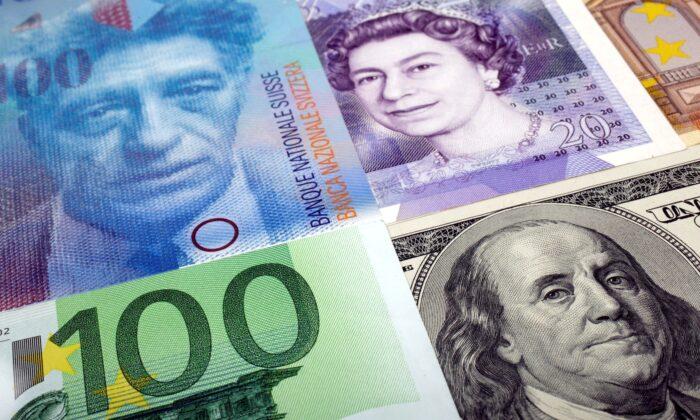LONDON—The dollar fell and sterling steadied on Tuesday as traders reckoned banking stress could keep the Federal Reserve and the Bank of England from hiking rates much further, or at all, later in the week.
Investors’ focus has moved to a slew of central bank meetings due this week after days of volatility in markets caused by worries over the stability of the global banking sector.
The Swiss franc rose sharply against the dollar on expectations of a 50-basis point hike on Thursday from the Swiss National Bank (SNB), matching the European Central Bank’s increase last week, as tackling inflation trumps concerns about financial market turmoil, according to a Reuters poll.
The dollar index, fell 0.3 percent to 103.02. The Swiss franc rose 0.6 percent to $0.92355, while sterling edged 0.2 percent lower to $1.2249.
Markets are pricing in a 85 percent chance of a 25-bp hike when the Fed announces its monetary policy decision on Wednesday. The Fed hikes’ peak was seen at 5.5 percent only a few weeks ago, against about 4.8 percent now.
The dollar has followed those expectations lower, though general nervousness in financial markets has tempered selling.
“Volatility in rates and the broader asset markets has been extraordinary recently,” said John Velis, FX and macro strategist for the Americas at BNY Mellon, causing a “substantial repricing” of future rate hikes.
Sterling moved a tad lower, staying close to an almost seven-week high against the dollar, after data showed Britain recorded a budget deficit of 16.68 billion pounds ($20.4 billion) in February, far above expectations in a Reuters poll.
“UK government borrowing data brought mixed news,” said Shaun Osborne, chief currency strategist at Scotiabank. While the borrowing requirement was high, “the government looks likely to undershoot borrowing estimates for the full year... That might mean more room for pre-election “sweeteners” later this year,” he said.
With UK inflation data on Wednesday expected to show some easing and amid the global financial market instability, money markets are now pricing in a 45 percent chance of no interest rate hike by the BoE on Thursday and a 55 percent chance of a 25 bps increase.
Norway’s central bank Norges Bank is expected to raise its benchmark interest rate by 25 bps to 3 percent this week to curb inflation and prop up a weakening currency, according to a Reuters poll.
The Norwegian crown surged 1.2 percent to 10.0913 per dollar, set for its biggest daily jump in almost six weeks, after falling last week to its lowest since early October.
On Tuesday, minutes showing Australia’s central bank had agreed on March 7 to consider the case for a rate pause at its April policy meeting, even before the recent bout of volatility weighed on the Aussie, which dropped 0.55 percent to $0.6682.
The euro rose 0.5 percent to $1.07805 after the ZEW economic research institute said on Tuesday German investor sentiment continued on the path to recovery last month.
But sentiment is fragile as investors are concerned over the outlook for the banking sector after U.S. lender First Republic shares tumbled nearly 50 percent on Monday on fears it will need a second rescue.
European banks rallied on Tuesday for a second consecutive day, as some of the initial concern sparked by UBS Group’s state-backed takeover of Credit Suisse eased.
A top European Union securities regulator said on Tuesday that reforms to tackle vulnerabilities in money market funds were urgently needed for the sector to cope better with economic shocks.
The dollar rose 0.86 percent against the yen to 132.4 after recording on Friday its biggest daily fall against the Japanese currency in more than two months.





